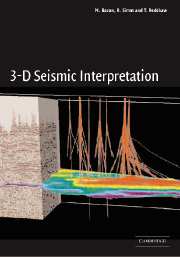Book contents
- Frontmatter
- Contents
- Preface
- 1 Introduction
- 2 3-D seismic data acquisition and processing
- 3 Structural interpretation
- 4 Geological interpretation
- 5 Interpreting seismic amplitudes
- 6 Inversion
- 7 3-D seismic data visualisation
- 8 Time-lapse seismic
- Appendix 1 Workstation issues
- Appendix 2 Glossary
- Appendix 3 Recent developments
- Index
- References
3 - Structural interpretation
Published online by Cambridge University Press: 05 March 2013
- Frontmatter
- Contents
- Preface
- 1 Introduction
- 2 3-D seismic data acquisition and processing
- 3 Structural interpretation
- 4 Geological interpretation
- 5 Interpreting seismic amplitudes
- 6 Inversion
- 7 3-D seismic data visualisation
- 8 Time-lapse seismic
- Appendix 1 Workstation issues
- Appendix 2 Glossary
- Appendix 3 Recent developments
- Index
- References
Summary
This chapter is mainly about the most fundamental interpretation activity: making maps of horizons. Historically, it was the need for better maps of complex structural traps that was a key driver in the early adoption of 3-D seismic. Usually, however, it is not enough just to map the top of the reservoir. To understand how structures were formed and when, it is usually necessary to map a range of marker horizons above and below the target. Also, depth conversion will, in most cases, require the mapping of several horizons above the target level.
This chapter begins by considering how stratigraphic horizons encountered in wells can be tied to particular reflections on a seismic survey; this is an issue for all seismic interpretation, and is often easier on a 3-D survey because of the more nearly correct positioning of subsurface features. Having decided what to map, the interpreter is faced with the daunting problem of working with a huge number of seismic traces, all of which should ideally be taken into account. Happily, the power of computer workstations has increased faster than the quantity of traces waiting to be interpreted; the chapter continues with an explanation of how the tracking of reflecting horizons through a 3-D volume can be partly automated. This is not a matter only of mapping the horizon itself; in an area of even moderate structural complexity, it is the mapping of fault systems that will consume much of the interpretation effort. Semi-automated methods can help here too.
Information
- Type
- Chapter
- Information
- 3-D Seismic Interpretation , pp. 57 - 101Publisher: Cambridge University PressPrint publication year: 2003
